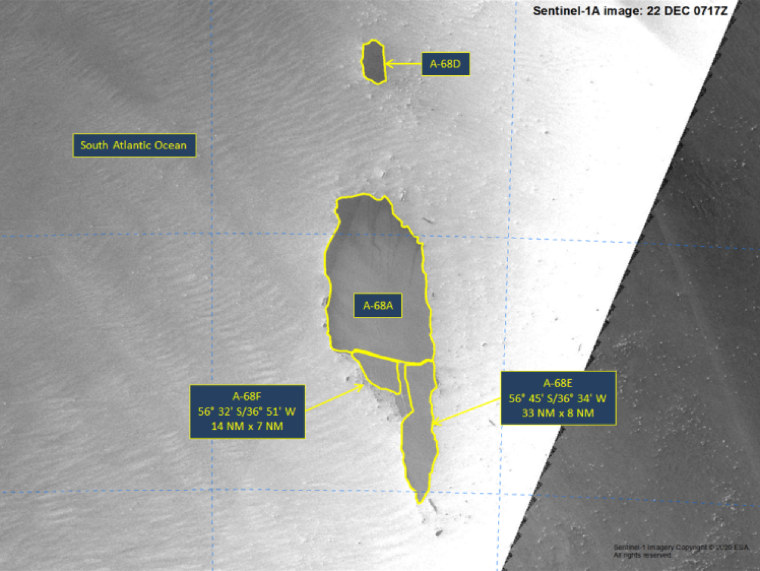An enormous iceberg that has been heading toward South Georgia Island in the southern Atlantic has broken up into three large chunks, according to scientists.
The iceberg — dubbed A68a by scientists — broke off from the Larsen C ice shelf in Antarctica in 2017. In recent weeks, it has come close to South Georgia Island, a remote British overseas territory off the southern tip of South America, raising concerns for the island’s wildlife.
Scientists worry that an iceberg could grind into the seabed of the wildlife-rich island of South Georgia and disrupt underwater ecosystems. They were also concerned that one or more icebergs might block penguins making their way into the sea for food.
A large number of whales, seals, and penguins feed off the coast of South Georgia.

Andrew Fleming, of the British Antarctic Survey, has been tracking A68a for over three years and told NBC News that two new icebergs, named A68e and A68f, were “calved” away from A68a on Tuesday.
The two new fragments, 253 and 87 square miles each, as well as the original A68a, now more than 1,000 square miles in size — about two-thirds the size of Rhode Island — are still huge, according to Fleming. They are expected to continue drifting close to South Georgia island and the potential for them to ground on the island still exists.
“The fragmentation does not remove the chance of it happening, but it won’t now be as one huge piece,” Fleming said. “But there is still the potential for it to disturb things.”
Download the NBC News app for breaking news and politics
Satellite imagery provided by the U.S. National Ice Center on Tuesday showed the boundaries of where the ice chunks have separated.
Satellite data has been crucial in monitoring the iceberg on its journey from birth to destruction, Adrian Luckman, satellite imaging glaciologist with U.K.'s Swansea University, told BBC.
"As well as being one of the largest icebergs ever recorded, A68 must also be one of the most watched," Luckman said, adding that the iceberg is finally beginning to disintegrate nearly 3.5 years since it calved away from Larsen C Ice Shelf.
Fleming said it will become more clear where the new iceberg chunks are headed in the next couple of days or weeks, but they are expected to be pushed by the ocean currents to the north side of the island.
He also expects more breakage as the two new iceberg fragments start disintegrating further.
Reuters contributed to this report.
